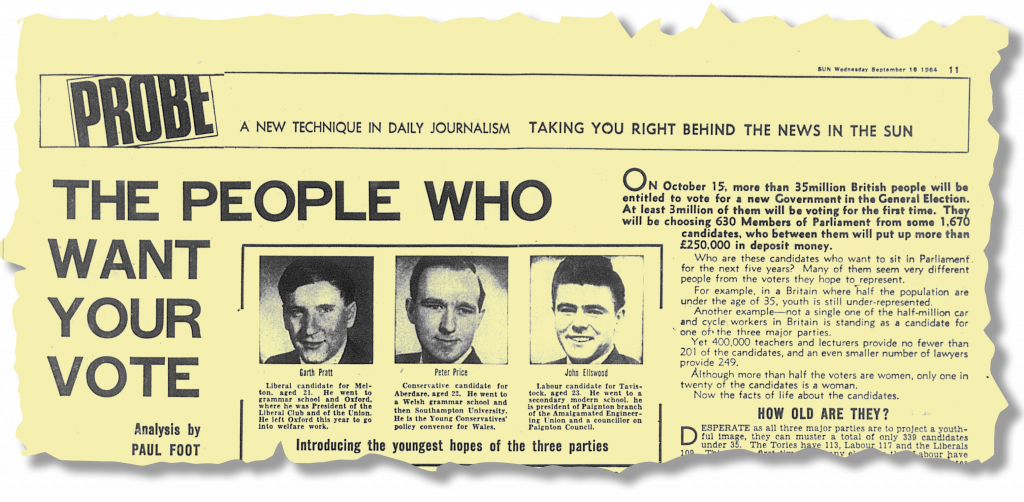On October 15, more than 35 million British people will be entitled to vote for a new Government in the General Election. At least 3 million of them will be voting for the first time. They will be choosing 630 Members of Parliament from some 1,670 candidates, who between them will put up more than £250,000 in deposit money.
Who are these candidates who want to sit in Parliament for the next five years? Many of them seem very different people from the voters they hope to represent.
For example, in a Britain where half the population are under the age of 35, youth is still under-represented
Another example — not a single one of the half-million car and cycle workers in Britain is standing as a candidate for one of the three major parties.
Yet 400,000 teachers and lecturers provide no fewer than 201 of the candidates, and an even smaller number of lawyers provide 249.
Although more than half the voters are women, only one in twenty of the candidates is a woman.
Now the facts of life about the candidates.
HOW OLD ARE THEY?
Desperate as all three major parties are to project a youthful image, they can muster a total of only 339 candidates under 35. The Tories have 113, Labour 117 and the Liberals 109. This is the first time for many elections that Labour have more under-35s than the Conservatives. Of the 216 candidates in their sixties, 91 are Labour, 71 Conservative and 54 Liberal. Most of the candidates are between 45 and 55.
WHERE DID THEY GO TO SCHOOL?
The old school tie is still much in evidence in the Tory Party. Nearly three-quarters of their candidates went to public schools and one in seven of them is an Old Etonian.
In the country as a whole only one child in every 30 goes to a public school and only one in 3,000 goes to Eton. Four-fifths of all British children go to secondary modern or technical schools. Only 2 p.c. of the Tory candidates did.
Just one child in every 100 gets to Oxford or Cambridge, but nearly half the Tory candidates went to one or the other.
On the other hand, a third of Labour’s candidates left school at 15 or earlier.
Labour have a total of 90 candidates who went to public schools. Most Labour candidates went to grammar schools, many of them going on-to “red brick” universities or technical colleges
The Liberals have the highest percentage of candidates who received some form of higher education 66 p.c. One-third of their candidates went to public schools, and half of them went to grammar schools. Only one in ten of the Liberal candidates went to a secondary modern or technical school.
WHAT ARE THEIR JOBS?
Conservatives drew most of their candidetes from the business world. About two-thirds of them are businessmen, lawyers with strong business connections or farmer-landowners.
When Mr. Raymond Mawby was elected for Totnes in 1955, he became the only Conservative MP to have left a manual job – he was an electrician — to go to Parliament. He will almost certainly keep that record throughout the next Parliament.
Liberal candidates are almost all white-collar workers, lawyers and small businessmen.
The Labour Party show a marked rise in the number of “white-collar” candidates they are putting forward. But, unlike the other parties, they still have a substantial number of candidates who are manual workers or trade union officials.
WHO IS LIKELY TO SUCCEED?
Of the 1.670 candidates, only 900 or so have slightest chance of success. The others are fighting a hopeless battle against “safe.” impregnable majorities.
What sort of people have the parties chosen to fight marginal seats and safe seats that have fallen vacant?
Of the 146 new Conservative candidates standing in Tory or marginal Labour constituencies, no fewer than 100 went to public schools (16 to Eton) and 60 to Oxford or Cambridge. There are 64 businessmen among them and one manual worker.
While the Conservatives enthusiastically reinforce their class traditions, Labour are trying desperately to alter theirs.
Party officials throughout the country have tried to end the cautious cloth-cap class-appeal by recruiting candidates with a more modern outlook. The number of young teachers and white-collar workers chosen as candidates shows the measure of their success.
But stalwarts in the trade unions have held on where it matters most-in the safe and marginal seats. Of the 113 new Labour candidates with any hope of success, 29 are manual workers or trade union offcials and only four are under 30.
In spite of the Liberal Party’s youthful image, only two of the 25 Liberal candidates with the slightest chance of success are under 30.
All parties proclaim their bellef in a classless society with equal educational opportunity. Only the figures can prove whether, when choosing their candidates, they practise as they preach.
